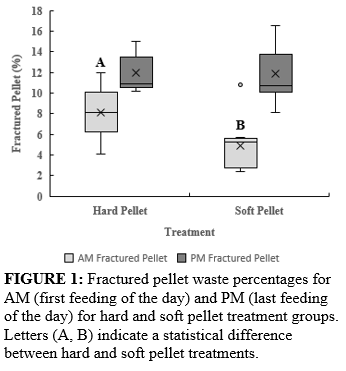EFFECTS OF HARD AND SOFT PELLETS IN CONJUNCTION WITH PELLET SIZE ON PRODUCTION CHARACTERISTICS OF FLORIDA POMPANO Trachinotus carolinus
Florida Pompano (Trachinotus carolinus) are on the path to commercialization in the US marine aquaculture industry. Florida Pompano are molluscivorous, and greater than 70% of their natural diet consists of hard-shelled gastropods and bivalves. They also eat crustaceans and other invertebrates. Florida Pompano possess a specialized feeding mechanism, the pharyngeal jaw, which forms a crushing surface used to grind their prey. In aquaculture, the hard-shelled prey are substituted with a prepared diet, an extruded pellet, and their feeding apparatus results in pellets fracturing and loss of fragments through their gill rakers. The main objective of this study was to examine if the uptake efficiency of Florida Pompano can be improved through feed manufacturing technology. Two experiments were conducted to address this: Experiment 1 (duration 294 days) examined whether the Feed Conversion Ratio (FCR) could be reduced by feeding smaller pellets than the fish would normally be fed to evaluate whether pellet size has an effect on the amount of fractured pellet wasted (collection method: 200 μm parabolic filter) during consumption. Experiment 2 (duration 90 days) addressed whether a soft extruded pellet (newly developed water stable semi-moist pellet) reduces the quantity of fractured pellet waste (collection method: large 200 μm sieve) relative to standard commercially produced hard extruded pellets.
No statistical difference was seen in fractured pellet waste between the standard pellet size and smaller pellet size treatments. Experiment 2 showed a statistical difference (Figure 1) in the morning (first feeding of the day) fractured pellet waste between the hard and soft pellet treatments, however, no statistical difference was seen in the late afternoon (last feeding of the day) fractured pellet waste. Our results suggest that pellet size does not reduce the amount of fractured pellet waste produced, while the use of soft versus hard pellets does reduce the amount of fractured waste.
